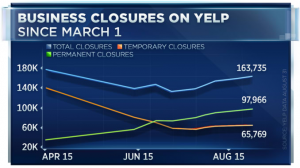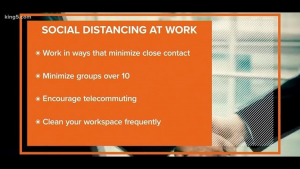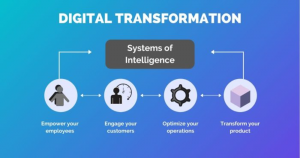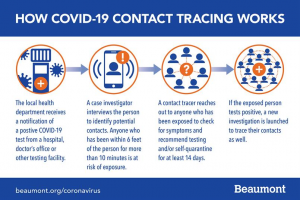
How to Use Digital Proximity and Digital Innovation Tools to Prevent Business Closures During a Pandemic
Are you looking for digital solutions that can help you deal with the challenges caused by the present pandemic?
According to Yelp data released in its September’s Economic Impact Report, 97,966 representing 60% of businesses have closed permanently due to the coronavirus pandemic. This is a 34% increase since mid-July, and the numbers are increasing.

The coronavirus outbreak has wreaked considerable havoc and has long-term implications for the global economy. It has shown businesses the value of digital operating models, forcing most companies to accelarate their digital innovation and transformation.
The pandemic is forcing healthcare systems worldwide to respond rapidly to the crisis. As a result, they are adopting different types of digital solutions. One might even say that the COVID-19 pandemic has provided an excellent opportunity to revolutionize proximity issues with digital innovation.
How is this period of digital innovation impacting your life and business?
So far, business owners were forced to identify and address the vulnerabilities in their businesses to beat the competition and survive. As the competition is becoming tougher now that the lockdown is easing and businesses are allowed to reopen, digital innovations have become essential, especially with the need for digital proximity tools.
Here are the topics this article will cover:
- What is a digital proximity device?
- How to move your business from social distancing to digital proximity
- How to fight COVID-19 through digital innovation
- How to take advantage of the COVID-19 pandemic to transform your business digitally.
Let’s delve in!
What is a Digital Proximity Device?
A digital proximity device uses proximity sensors to detect people at a certain sensing distance without necessarily making physical contact with them.
A proximity sensor typically emits an electromagnetic field or an electromagnetic radiation beam. It then searches for any changes in the field or any return signal. The type of proximity sensor target will determine the kind of sensor that is used.

Proximity devices use sensors that are highly reliable and have an extended operational life. This is due to the absence of mechanical parts and non-existent physical contact between both the sensor and the object that is sensed.
Proximity device sensors are often used on mobile devices. So when a target is within the normal range, the lock screen of the device’s user interface will appear. If the target does not move for some time after awaking the phone from sleep mode, the sensor will ignore it and revert to sleep mode.
The major types of sensors used for proximity are:
- Inductive sensors
- Capacitive sensors
- Magnetic sensors
- Photoelectric sensors
- Ultrasonic sensors
- Optical sensors
- Doppler effect sensors
- Retroreflective sensors
Do digital proximity devices for social distancing work in the same way?
Yes, they do. They can be designed to detect motion up to 6 feet. As a matter of fact, digital proximity is one of the most significant digital innovations of these challenging times.
How to Move Your Business from Social Distancing to Digital Proximity
The novel COVID-19 pandemic brought many uncertainties for business owners and employees alike. Many economies are experiencing significant hardship. In the long run, all businesses will have to adapt to survive.
The “stay-at-home” order to fight COVID-19 has impacted the world in so many ways. Social distancing is a new and on-going norm for years to come. Preventative measures like signage and tape lines have been implemented to help curb the spread of the disease.

But will people stick to these rules? Do people still fear proximity?
Human beings crave social interaction, and social distancing rules will be incredibly challenging to adhere to, especially in the workplace.
Companies now have to be agile to gain a competitive advantage and make smart decisions in this digital transformation era.

Hence, the need to create a new normal for people while keeping them safe, especially in their workplaces. This can only be accomplished by digital innovations that people can use to stay safe without feeling inconvenienced, distracted, or self-conscious.
How to Fight COVID-19 Through Digital Innovation
Digital innovation is not just something that software companies do. It actually means innovating processes, products, or business models by using digital technology platforms.
COVID-19 has had a devastating impact on our personal lives and businesses. As Tata Consultancy Services’ global head of mortgage practice, Karthik Kumar, puts it, “This crisis has inspired creative thinking to its highest order.”
Many digital innovations and technologies have captured our attention amid this global pandemic. These technologies have shown considerable potential in fighting COVID-19.
Here are some of the latest coronavirus inventions:
Ventilators and masks
Dr. Rhys Thomas joined the fight against coronavirus by designing a simple and robust ventilator that can help coronavirus patients breathe while killing the virus at the same time.
According to him, “Although it won’t replace an ICU ventilator, the majority of patients won’t need intensive care if they are treated with this ventilator first. The machine will [also] clean the room of viral particles and only supply purified air to the patient. The patient can self-care, releasing specialist nurses for other duties.”
Another innovation is a snood mask by Virustatic Shield. This mask, with its antiviral coating, could really save lives. They are planning to scale up production, allowing more people access to their snood mask.
Door-opening devices
Different models of hygienic door hooks are available to help reduce the spread of the virus by opening public doors. Since the virus can live on some surfaces for up to three days, these devices are game changers in places where hand sanitizers are most needed, like hospital wards.
One such hands-free door opener is the Hygiene Hook designed by Steve Brooks. This device, made from a non-porous material that is very easy to clean, is so portable that it can fit into your pocket. It comes in four varieties, and Steve Brooks donates a hook for every one of the devices he sells.
Another designer, Welshman Wyn Griffiths, has come up with a hands-free door opener that clips onto door handles. This opener allows you to operate door handles with your forearm. Griffiths designed this door opener after his wife saw the challenges faced by hospital staff while working. He has distributed the 3D design for free online so that people can print and use it.
In an interview with BBC, Griffiths said, “Hopefully people who have a 3D printer can help out their local hospital or anywhere the public visits by distributing these around the country.”
Contact tracing and proximity devices
Another stroke of genius is the amazing design of devices that ensure people maintain a social distance while keeping track of their movements, especially in a controlled environment.
smartspace by Seguro LLC is leading this innovation by providing instant device-to-device tracing suitable for controlled businesses or community environments, aiming to create a new normal for people in these settings.
The best of its kind, this device uses ultra-wideband technology that is accurate to within 4 inches. The device connects to your phone using Bluetooth Low Energy and lasts up to 2 weeks. Therefore, it does it require frequent recharging.
This portable device is just slightly larger than a credit card and works with an app that you can install on any Android or iOS phone. It is triggered when you are closer than 6 feet to another user and also shows you how long 2 devices were in close proximity to each other.
With these hardware and software components, you can track interactions by downloading real-time data that you can use to mitigate risks and guard your workforce. The smartspace is user-friendly and has a dashboard that is very easy to use.
This is an outstanding innovation that will be ideal for schools, construction companies, healthcare facilities, manufacturing industries, retirement communities, and offices. It is readily available for use now and after the COVID-19 pandemic is over.
How To Take Advantage of the COVID-19 Pandemic to Transform Your Business Digitally
For many years, most companies did not even see the need to incorporate digital tools into their businesses. As a matter of fact, digital innovation was often the last item on the company’s to-do list.
However, COVID-19 required many businesses to run remotely. This activated the survival instinct of most business owners, and they realized that they needed to start allocating resources to acquire digital tools. In the long run, this has been a good thing for tech companies.
The competitive landscape spurred on by COVID-19 ensures that whoever adapts and uses the best innovative tools will stay alive. Meanwhile, the businesses with the highest chance of survival during and after this pandemic are those that can adapt, innovate, and adopt digital processes and tools.
What can you do to accelerate your outcome and beat the competition?
You can start by cultivating a continuous innovative culture in your company. Here are some tips to help you get started:
Tip 1: Select the right people
Build a team consisting of two or three highly focused and passionate people who can put their heads together to come up with digital solutions to complicated business challenges. The people you chose could come from your workforce. Just ensure they can deliver business value and increase ROI.
Tip 2: Leverage an agile process
Take advantage of an iterative yet agile process to improve innovation without disrupting the existing operations of your company. When you do this continuously, you will enjoy more frequent digital functionality, see progress, get more market feedback, and drive development efforts.
Tip 3: Find a platform
Get the technology that best suits your kind of business and use it to empower your workforce so that you can bolster your process. For instance, the smartspace digital tool for proximity detection and contact tracing is suitable for all controlled environments, such as hospitals, manufacturing companies, schools, offices, and retirement communities.

Be sure to choose a unified platform that can manage the lifecycle of the application, including team collaboration, program management, application management, instant cloud deployment, and rapid application development.
Tip 4: Create a project portfolio
When you create a project portfolio of high-value initiatives and quick wins, you will most likely enjoy immediate success and leave your customers, stakeholders, and competitors amazed.
Although these high-value initiatives will require a substantial change in your organizational structure, the result is worth it. A broader organizational change can result from applications that are linked to relevant strategic initiatives.
Tip 5: Monitor assets remotely
This appears to be the biggest upside of digitization during this pandemic. Most of the inventions use digital tools, such as remote equipment management in office environments, GPS asset tracking in supply chain management, or room usage monitoring in general office environments.
Workers can now monitor and control machines remotely using smart sensors installed on different machines. Instead of being exposed to other workers and risking infection, they can use the data from these smart sensors to perform virtual inspections and diagnostics.
Tip 6: Enable physical distancing in workplaces
The nature of many facilities require workers to be in close proximity to each other. In environments like construction sites and warehouses, the number of people on-site at a time should be reduced. Additionally, it is necessary to provide additional safe distancing protection using digital technologies.
But, how can you ensure the optimal safe distance and still allow workers to focus on their duties?
You can create an extra buffer zone for contagion control using a contact tracing and social distancing tool. The best digital system so far that can be utilized for this purpose during and after the COVID-19 pandemic is the smartspace tool.
Whether it is a healthcare institution, construction site, or office space, you can equip each of your workers with one of these compact proximity tags, connected to software downloaded on an Android or iOS phone.
This enables you to easily monitor interactions between workers to identify possible contamination clusters and limit its impact. In this way, companies and organizations can better monitor their workers’ exposure, keep them safe, and store data in real-time to prevent facilities from shutting down.
So, now you have the right information, run with it!
Several inventions have become essential parts of our daily lives since the coronavirus became a global pandemic. Human ingenuity in these trying times provides us with a glimmer of hope that, together, we can beat this menace.
At Seguro LLC, we fully understand your fears now that you are set to reopen for business. Keeping your workforce safe while going about their duties can present a challenge. However, with our innovation-enabled smartspace contact tracing device, we provide a digital solution to ease your fears.
If you are skeptical about the health and safety of your workforce, we can help you to leverage digitization to get your business booming again with workers who are safe, sound, and motivated.

Sorry, the comment form is closed at this time.